1807NRS: Safe Administration of Medications Report - Healthcare
VerifiedAdded on 2020/02/19
|12
|3228
|260
Report
AI Summary
This report provides a comprehensive overview of safe medication administration, addressing key aspects such as the phases of clinical trials, the role of the Therapeutic Goods Administration (TGA), and the principles of pharmacokinetics and pharmacodynamics. It explores the hepatic first-pass effect in relation to oral medications and discusses the specific administration of Glyceryl Trinitrate. The report outlines the responsibilities of registered nurses, pharmacists, and doctors in medication management, and it identifies various types of medication errors, their causes, and strategies for prevention, including the person-centered and system-approach, and the Swiss cheese model. Additionally, it examines factors contributing to medication errors, emphasizing both individual and organizational influences.
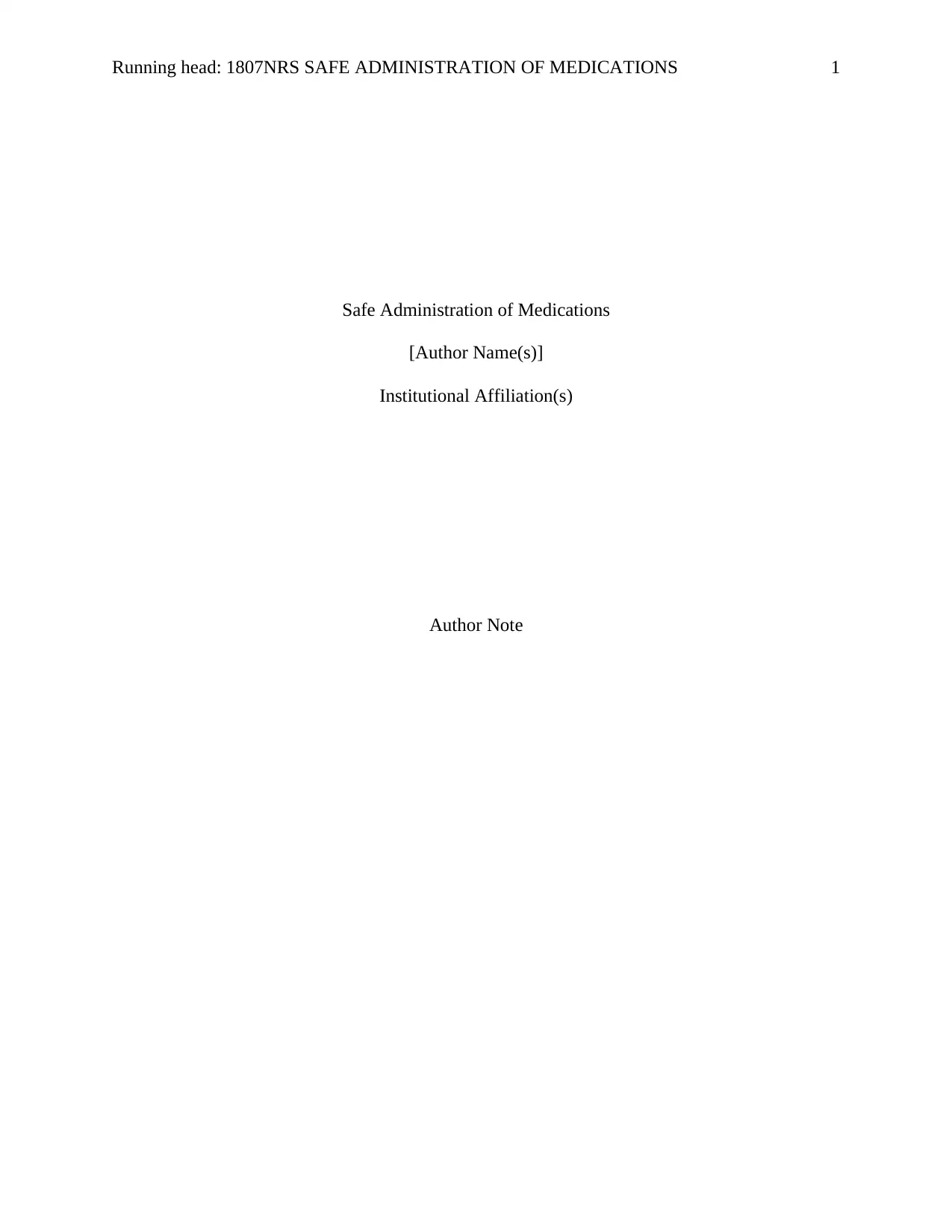
Running head: 1807NRS SAFE ADMINISTRATION OF MEDICATIONS 1
Safe Administration of Medications
[Author Name(s)]
Institutional Affiliation(s)
Author Note
Safe Administration of Medications
[Author Name(s)]
Institutional Affiliation(s)
Author Note
Paraphrase This Document
Need a fresh take? Get an instant paraphrase of this document with our AI Paraphraser
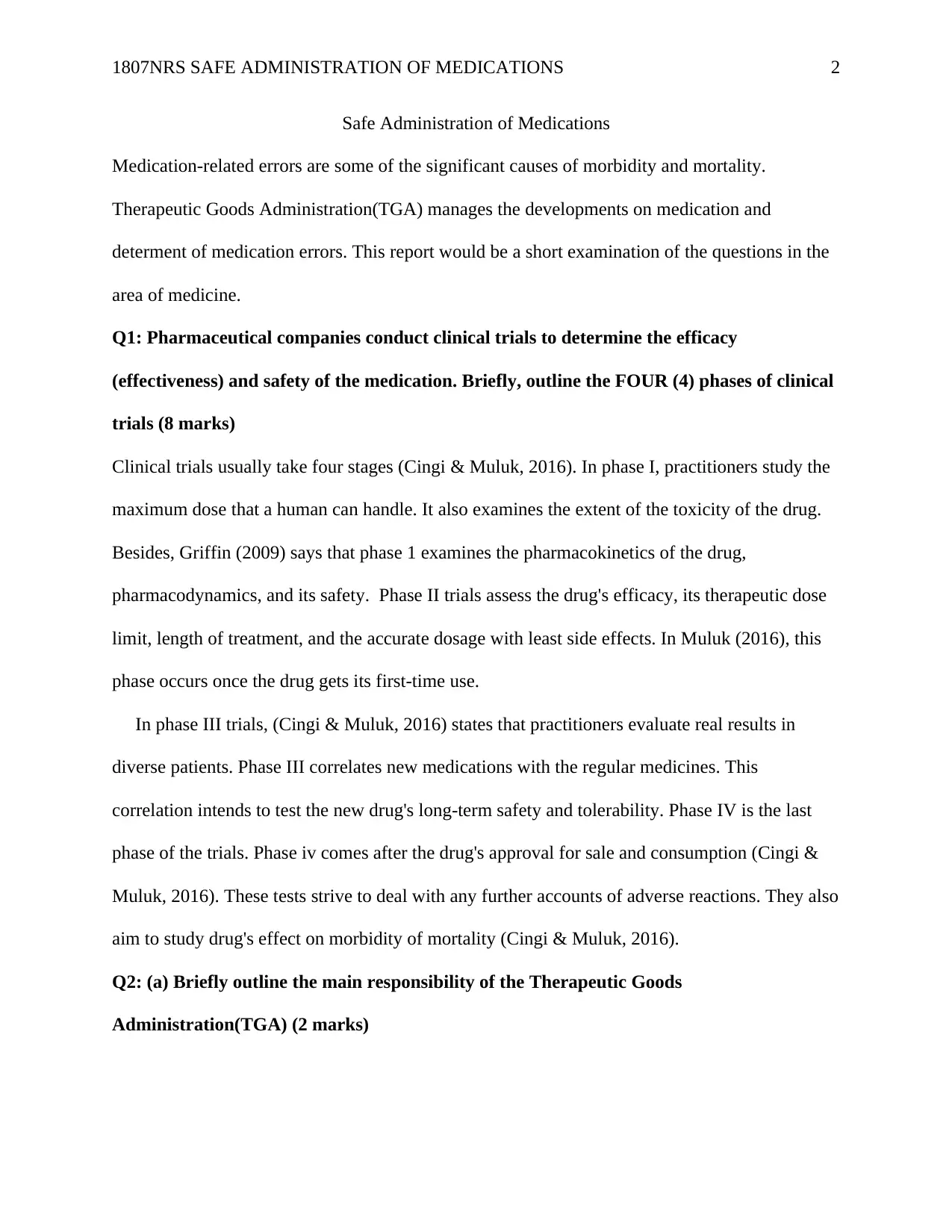
1807NRS SAFE ADMINISTRATION OF MEDICATIONS 2
Safe Administration of Medications
Medication-related errors are some of the significant causes of morbidity and mortality.
Therapeutic Goods Administration(TGA) manages the developments on medication and
determent of medication errors. This report would be a short examination of the questions in the
area of medicine.
Q1: Pharmaceutical companies conduct clinical trials to determine the efficacy
(effectiveness) and safety of the medication. Briefly, outline the FOUR (4) phases of clinical
trials (8 marks)
Clinical trials usually take four stages (Cingi & Muluk, 2016). In phase I, practitioners study the
maximum dose that a human can handle. It also examines the extent of the toxicity of the drug.
Besides, Griffin (2009) says that phase 1 examines the pharmacokinetics of the drug,
pharmacodynamics, and its safety. Phase II trials assess the drug's efficacy, its therapeutic dose
limit, length of treatment, and the accurate dosage with least side effects. In Muluk (2016), this
phase occurs once the drug gets its first-time use.
In phase III trials, (Cingi & Muluk, 2016) states that practitioners evaluate real results in
diverse patients. Phase III correlates new medications with the regular medicines. This
correlation intends to test the new drug's long-term safety and tolerability. Phase IV is the last
phase of the trials. Phase iv comes after the drug's approval for sale and consumption (Cingi &
Muluk, 2016). These tests strive to deal with any further accounts of adverse reactions. They also
aim to study drug's effect on morbidity of mortality (Cingi & Muluk, 2016).
Q2: (a) Briefly outline the main responsibility of the Therapeutic Goods
Administration(TGA) (2 marks)
Safe Administration of Medications
Medication-related errors are some of the significant causes of morbidity and mortality.
Therapeutic Goods Administration(TGA) manages the developments on medication and
determent of medication errors. This report would be a short examination of the questions in the
area of medicine.
Q1: Pharmaceutical companies conduct clinical trials to determine the efficacy
(effectiveness) and safety of the medication. Briefly, outline the FOUR (4) phases of clinical
trials (8 marks)
Clinical trials usually take four stages (Cingi & Muluk, 2016). In phase I, practitioners study the
maximum dose that a human can handle. It also examines the extent of the toxicity of the drug.
Besides, Griffin (2009) says that phase 1 examines the pharmacokinetics of the drug,
pharmacodynamics, and its safety. Phase II trials assess the drug's efficacy, its therapeutic dose
limit, length of treatment, and the accurate dosage with least side effects. In Muluk (2016), this
phase occurs once the drug gets its first-time use.
In phase III trials, (Cingi & Muluk, 2016) states that practitioners evaluate real results in
diverse patients. Phase III correlates new medications with the regular medicines. This
correlation intends to test the new drug's long-term safety and tolerability. Phase IV is the last
phase of the trials. Phase iv comes after the drug's approval for sale and consumption (Cingi &
Muluk, 2016). These tests strive to deal with any further accounts of adverse reactions. They also
aim to study drug's effect on morbidity of mortality (Cingi & Muluk, 2016).
Q2: (a) Briefly outline the main responsibility of the Therapeutic Goods
Administration(TGA) (2 marks)
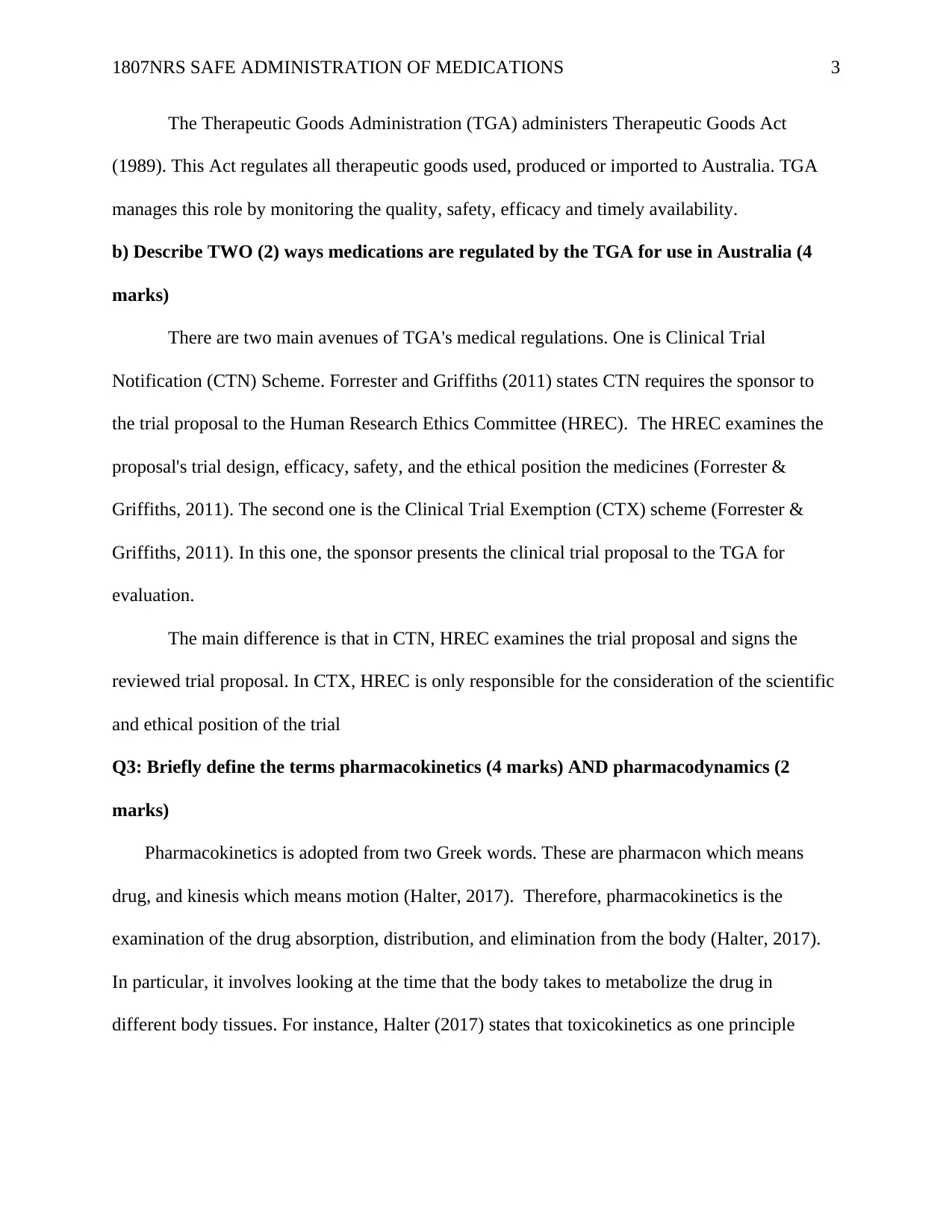
1807NRS SAFE ADMINISTRATION OF MEDICATIONS 3
The Therapeutic Goods Administration (TGA) administers Therapeutic Goods Act
(1989). This Act regulates all therapeutic goods used, produced or imported to Australia. TGA
manages this role by monitoring the quality, safety, efficacy and timely availability.
b) Describe TWO (2) ways medications are regulated by the TGA for use in Australia (4
marks)
There are two main avenues of TGA's medical regulations. One is Clinical Trial
Notification (CTN) Scheme. Forrester and Griffiths (2011) states CTN requires the sponsor to
the trial proposal to the Human Research Ethics Committee (HREC). The HREC examines the
proposal's trial design, efficacy, safety, and the ethical position the medicines (Forrester &
Griffiths, 2011). The second one is the Clinical Trial Exemption (CTX) scheme (Forrester &
Griffiths, 2011). In this one, the sponsor presents the clinical trial proposal to the TGA for
evaluation.
The main difference is that in CTN, HREC examines the trial proposal and signs the
reviewed trial proposal. In CTX, HREC is only responsible for the consideration of the scientific
and ethical position of the trial
Q3: Briefly define the terms pharmacokinetics (4 marks) AND pharmacodynamics (2
marks)
Pharmacokinetics is adopted from two Greek words. These are pharmacon which means
drug, and kinesis which means motion (Halter, 2017). Therefore, pharmacokinetics is the
examination of the drug absorption, distribution, and elimination from the body (Halter, 2017).
In particular, it involves looking at the time that the body takes to metabolize the drug in
different body tissues. For instance, Halter (2017) states that toxicokinetics as one principle
The Therapeutic Goods Administration (TGA) administers Therapeutic Goods Act
(1989). This Act regulates all therapeutic goods used, produced or imported to Australia. TGA
manages this role by monitoring the quality, safety, efficacy and timely availability.
b) Describe TWO (2) ways medications are regulated by the TGA for use in Australia (4
marks)
There are two main avenues of TGA's medical regulations. One is Clinical Trial
Notification (CTN) Scheme. Forrester and Griffiths (2011) states CTN requires the sponsor to
the trial proposal to the Human Research Ethics Committee (HREC). The HREC examines the
proposal's trial design, efficacy, safety, and the ethical position the medicines (Forrester &
Griffiths, 2011). The second one is the Clinical Trial Exemption (CTX) scheme (Forrester &
Griffiths, 2011). In this one, the sponsor presents the clinical trial proposal to the TGA for
evaluation.
The main difference is that in CTN, HREC examines the trial proposal and signs the
reviewed trial proposal. In CTX, HREC is only responsible for the consideration of the scientific
and ethical position of the trial
Q3: Briefly define the terms pharmacokinetics (4 marks) AND pharmacodynamics (2
marks)
Pharmacokinetics is adopted from two Greek words. These are pharmacon which means
drug, and kinesis which means motion (Halter, 2017). Therefore, pharmacokinetics is the
examination of the drug absorption, distribution, and elimination from the body (Halter, 2017).
In particular, it involves looking at the time that the body takes to metabolize the drug in
different body tissues. For instance, Halter (2017) states that toxicokinetics as one principle
⊘ This is a preview!⊘
Do you want full access?
Subscribe today to unlock all pages.

Trusted by 1+ million students worldwide
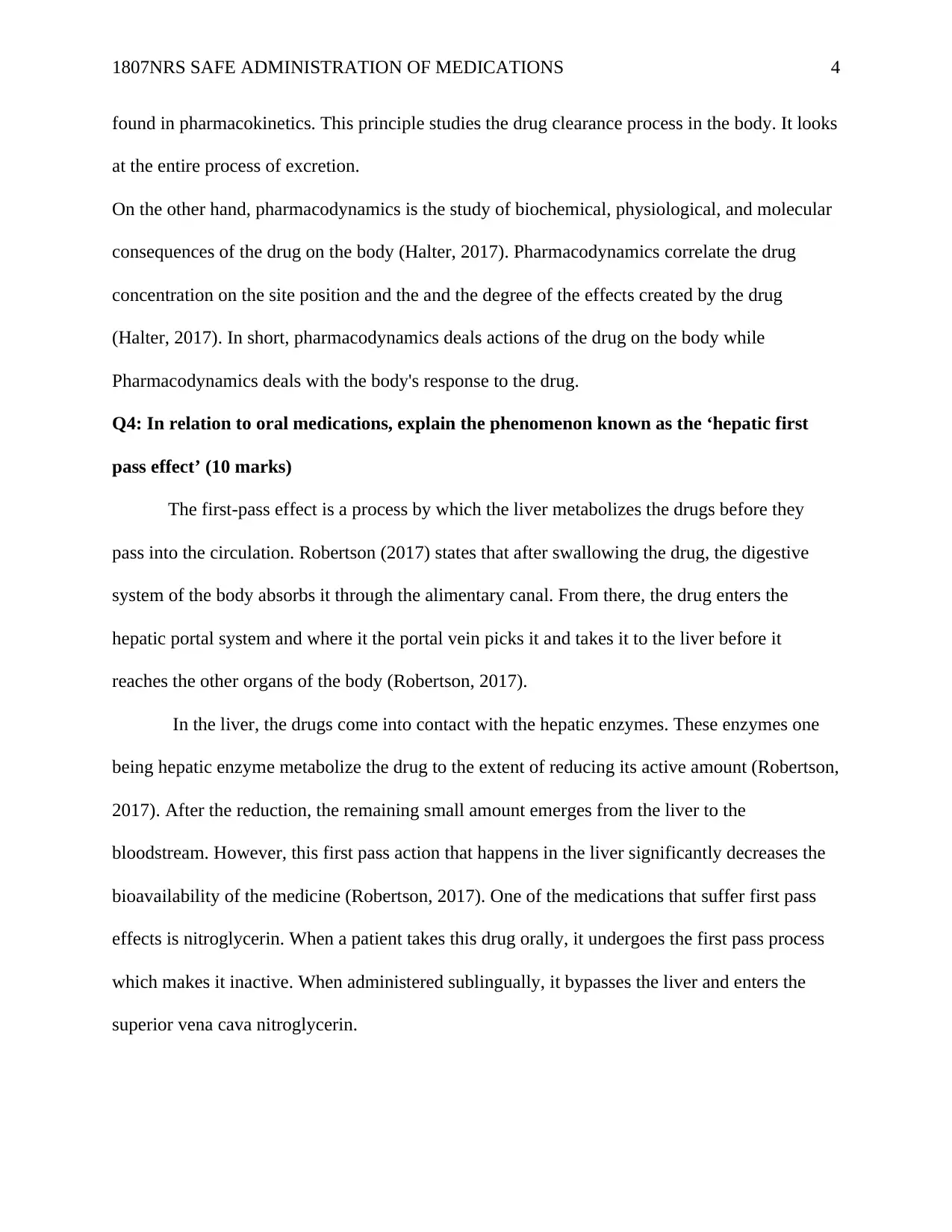
1807NRS SAFE ADMINISTRATION OF MEDICATIONS 4
found in pharmacokinetics. This principle studies the drug clearance process in the body. It looks
at the entire process of excretion.
On the other hand, pharmacodynamics is the study of biochemical, physiological, and molecular
consequences of the drug on the body (Halter, 2017). Pharmacodynamics correlate the drug
concentration on the site position and the and the degree of the effects created by the drug
(Halter, 2017). In short, pharmacodynamics deals actions of the drug on the body while
Pharmacodynamics deals with the body's response to the drug.
Q4: In relation to oral medications, explain the phenomenon known as the ‘hepatic first
pass effect’ (10 marks)
The first-pass effect is a process by which the liver metabolizes the drugs before they
pass into the circulation. Robertson (2017) states that after swallowing the drug, the digestive
system of the body absorbs it through the alimentary canal. From there, the drug enters the
hepatic portal system and where it the portal vein picks it and takes it to the liver before it
reaches the other organs of the body (Robertson, 2017).
In the liver, the drugs come into contact with the hepatic enzymes. These enzymes one
being hepatic enzyme metabolize the drug to the extent of reducing its active amount (Robertson,
2017). After the reduction, the remaining small amount emerges from the liver to the
bloodstream. However, this first pass action that happens in the liver significantly decreases the
bioavailability of the medicine (Robertson, 2017). One of the medications that suffer first pass
effects is nitroglycerin. When a patient takes this drug orally, it undergoes the first pass process
which makes it inactive. When administered sublingually, it bypasses the liver and enters the
superior vena cava nitroglycerin.
found in pharmacokinetics. This principle studies the drug clearance process in the body. It looks
at the entire process of excretion.
On the other hand, pharmacodynamics is the study of biochemical, physiological, and molecular
consequences of the drug on the body (Halter, 2017). Pharmacodynamics correlate the drug
concentration on the site position and the and the degree of the effects created by the drug
(Halter, 2017). In short, pharmacodynamics deals actions of the drug on the body while
Pharmacodynamics deals with the body's response to the drug.
Q4: In relation to oral medications, explain the phenomenon known as the ‘hepatic first
pass effect’ (10 marks)
The first-pass effect is a process by which the liver metabolizes the drugs before they
pass into the circulation. Robertson (2017) states that after swallowing the drug, the digestive
system of the body absorbs it through the alimentary canal. From there, the drug enters the
hepatic portal system and where it the portal vein picks it and takes it to the liver before it
reaches the other organs of the body (Robertson, 2017).
In the liver, the drugs come into contact with the hepatic enzymes. These enzymes one
being hepatic enzyme metabolize the drug to the extent of reducing its active amount (Robertson,
2017). After the reduction, the remaining small amount emerges from the liver to the
bloodstream. However, this first pass action that happens in the liver significantly decreases the
bioavailability of the medicine (Robertson, 2017). One of the medications that suffer first pass
effects is nitroglycerin. When a patient takes this drug orally, it undergoes the first pass process
which makes it inactive. When administered sublingually, it bypasses the liver and enters the
superior vena cava nitroglycerin.
Paraphrase This Document
Need a fresh take? Get an instant paraphrase of this document with our AI Paraphraser
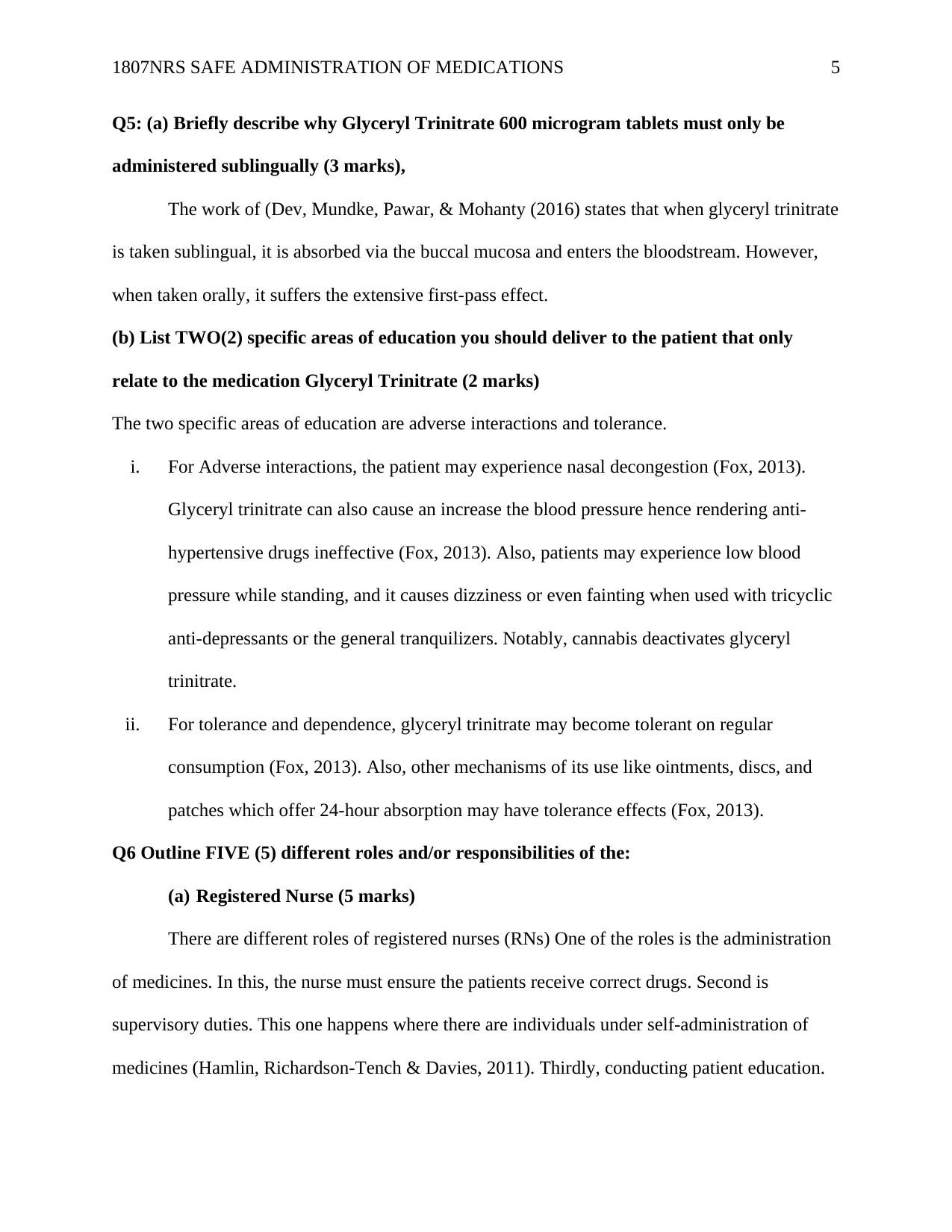
1807NRS SAFE ADMINISTRATION OF MEDICATIONS 5
Q5: (a) Briefly describe why Glyceryl Trinitrate 600 microgram tablets must only be
administered sublingually (3 marks),
The work of (Dev, Mundke, Pawar, & Mohanty (2016) states that when glyceryl trinitrate
is taken sublingual, it is absorbed via the buccal mucosa and enters the bloodstream. However,
when taken orally, it suffers the extensive first-pass effect.
(b) List TWO(2) specific areas of education you should deliver to the patient that only
relate to the medication Glyceryl Trinitrate (2 marks)
The two specific areas of education are adverse interactions and tolerance.
i. For Adverse interactions, the patient may experience nasal decongestion (Fox, 2013).
Glyceryl trinitrate can also cause an increase the blood pressure hence rendering anti-
hypertensive drugs ineffective (Fox, 2013). Also, patients may experience low blood
pressure while standing, and it causes dizziness or even fainting when used with tricyclic
anti-depressants or the general tranquilizers. Notably, cannabis deactivates glyceryl
trinitrate.
ii. For tolerance and dependence, glyceryl trinitrate may become tolerant on regular
consumption (Fox, 2013). Also, other mechanisms of its use like ointments, discs, and
patches which offer 24-hour absorption may have tolerance effects (Fox, 2013).
Q6 Outline FIVE (5) different roles and/or responsibilities of the:
(a) Registered Nurse (5 marks)
There are different roles of registered nurses (RNs) One of the roles is the administration
of medicines. In this, the nurse must ensure the patients receive correct drugs. Second is
supervisory duties. This one happens where there are individuals under self-administration of
medicines (Hamlin, Richardson-Tench & Davies, 2011). Thirdly, conducting patient education.
Q5: (a) Briefly describe why Glyceryl Trinitrate 600 microgram tablets must only be
administered sublingually (3 marks),
The work of (Dev, Mundke, Pawar, & Mohanty (2016) states that when glyceryl trinitrate
is taken sublingual, it is absorbed via the buccal mucosa and enters the bloodstream. However,
when taken orally, it suffers the extensive first-pass effect.
(b) List TWO(2) specific areas of education you should deliver to the patient that only
relate to the medication Glyceryl Trinitrate (2 marks)
The two specific areas of education are adverse interactions and tolerance.
i. For Adverse interactions, the patient may experience nasal decongestion (Fox, 2013).
Glyceryl trinitrate can also cause an increase the blood pressure hence rendering anti-
hypertensive drugs ineffective (Fox, 2013). Also, patients may experience low blood
pressure while standing, and it causes dizziness or even fainting when used with tricyclic
anti-depressants or the general tranquilizers. Notably, cannabis deactivates glyceryl
trinitrate.
ii. For tolerance and dependence, glyceryl trinitrate may become tolerant on regular
consumption (Fox, 2013). Also, other mechanisms of its use like ointments, discs, and
patches which offer 24-hour absorption may have tolerance effects (Fox, 2013).
Q6 Outline FIVE (5) different roles and/or responsibilities of the:
(a) Registered Nurse (5 marks)
There are different roles of registered nurses (RNs) One of the roles is the administration
of medicines. In this, the nurse must ensure the patients receive correct drugs. Second is
supervisory duties. This one happens where there are individuals under self-administration of
medicines (Hamlin, Richardson-Tench & Davies, 2011). Thirdly, conducting patient education.
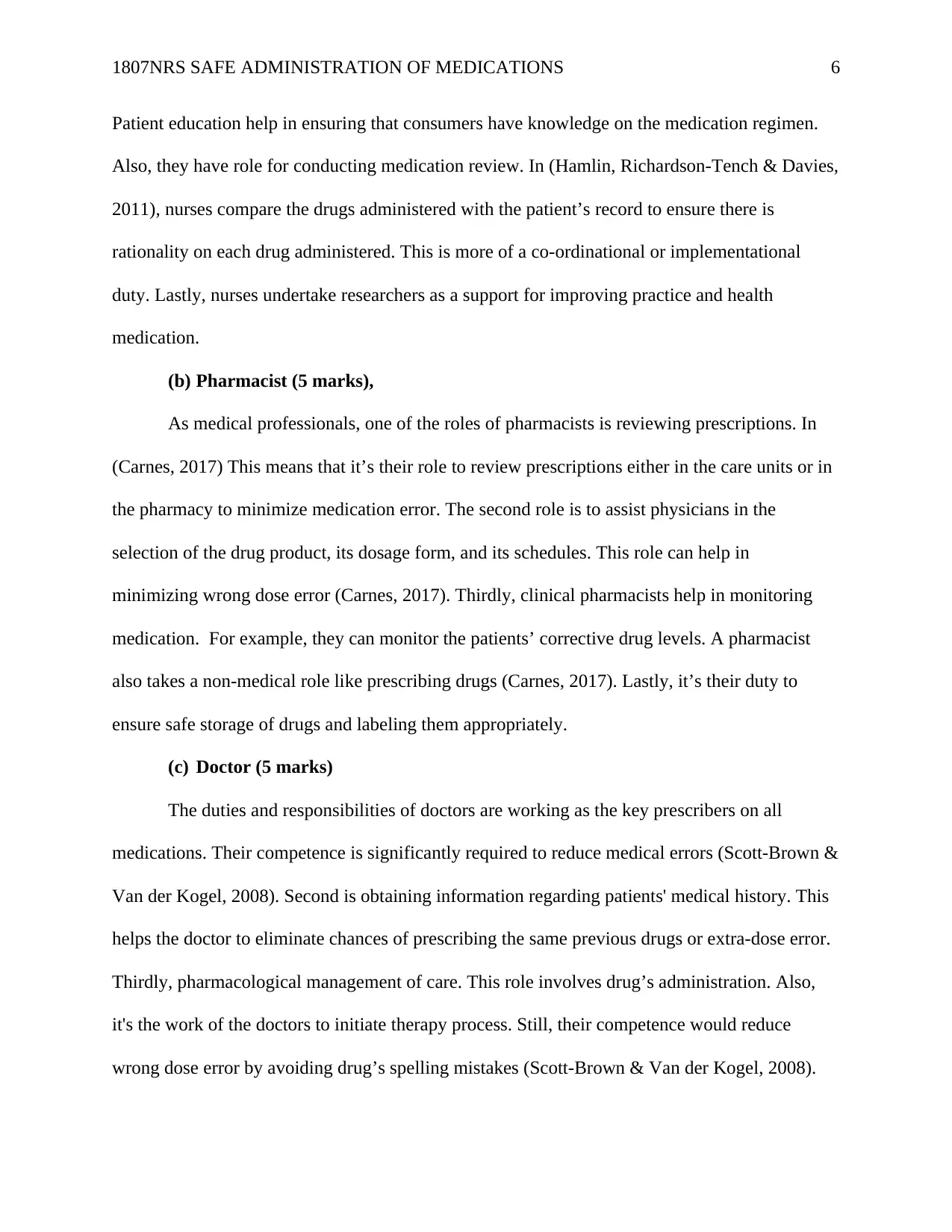
1807NRS SAFE ADMINISTRATION OF MEDICATIONS 6
Patient education help in ensuring that consumers have knowledge on the medication regimen.
Also, they have role for conducting medication review. In (Hamlin, Richardson-Tench & Davies,
2011), nurses compare the drugs administered with the patient’s record to ensure there is
rationality on each drug administered. This is more of a co-ordinational or implementational
duty. Lastly, nurses undertake researchers as a support for improving practice and health
medication.
(b) Pharmacist (5 marks),
As medical professionals, one of the roles of pharmacists is reviewing prescriptions. In
(Carnes, 2017) This means that it’s their role to review prescriptions either in the care units or in
the pharmacy to minimize medication error. The second role is to assist physicians in the
selection of the drug product, its dosage form, and its schedules. This role can help in
minimizing wrong dose error (Carnes, 2017). Thirdly, clinical pharmacists help in monitoring
medication. For example, they can monitor the patients’ corrective drug levels. A pharmacist
also takes a non-medical role like prescribing drugs (Carnes, 2017). Lastly, it’s their duty to
ensure safe storage of drugs and labeling them appropriately.
(c) Doctor (5 marks)
The duties and responsibilities of doctors are working as the key prescribers on all
medications. Their competence is significantly required to reduce medical errors (Scott-Brown &
Van der Kogel, 2008). Second is obtaining information regarding patients' medical history. This
helps the doctor to eliminate chances of prescribing the same previous drugs or extra-dose error.
Thirdly, pharmacological management of care. This role involves drug’s administration. Also,
it's the work of the doctors to initiate therapy process. Still, their competence would reduce
wrong dose error by avoiding drug’s spelling mistakes (Scott-Brown & Van der Kogel, 2008).
Patient education help in ensuring that consumers have knowledge on the medication regimen.
Also, they have role for conducting medication review. In (Hamlin, Richardson-Tench & Davies,
2011), nurses compare the drugs administered with the patient’s record to ensure there is
rationality on each drug administered. This is more of a co-ordinational or implementational
duty. Lastly, nurses undertake researchers as a support for improving practice and health
medication.
(b) Pharmacist (5 marks),
As medical professionals, one of the roles of pharmacists is reviewing prescriptions. In
(Carnes, 2017) This means that it’s their role to review prescriptions either in the care units or in
the pharmacy to minimize medication error. The second role is to assist physicians in the
selection of the drug product, its dosage form, and its schedules. This role can help in
minimizing wrong dose error (Carnes, 2017). Thirdly, clinical pharmacists help in monitoring
medication. For example, they can monitor the patients’ corrective drug levels. A pharmacist
also takes a non-medical role like prescribing drugs (Carnes, 2017). Lastly, it’s their duty to
ensure safe storage of drugs and labeling them appropriately.
(c) Doctor (5 marks)
The duties and responsibilities of doctors are working as the key prescribers on all
medications. Their competence is significantly required to reduce medical errors (Scott-Brown &
Van der Kogel, 2008). Second is obtaining information regarding patients' medical history. This
helps the doctor to eliminate chances of prescribing the same previous drugs or extra-dose error.
Thirdly, pharmacological management of care. This role involves drug’s administration. Also,
it's the work of the doctors to initiate therapy process. Still, their competence would reduce
wrong dose error by avoiding drug’s spelling mistakes (Scott-Brown & Van der Kogel, 2008).
⊘ This is a preview!⊘
Do you want full access?
Subscribe today to unlock all pages.

Trusted by 1+ million students worldwide
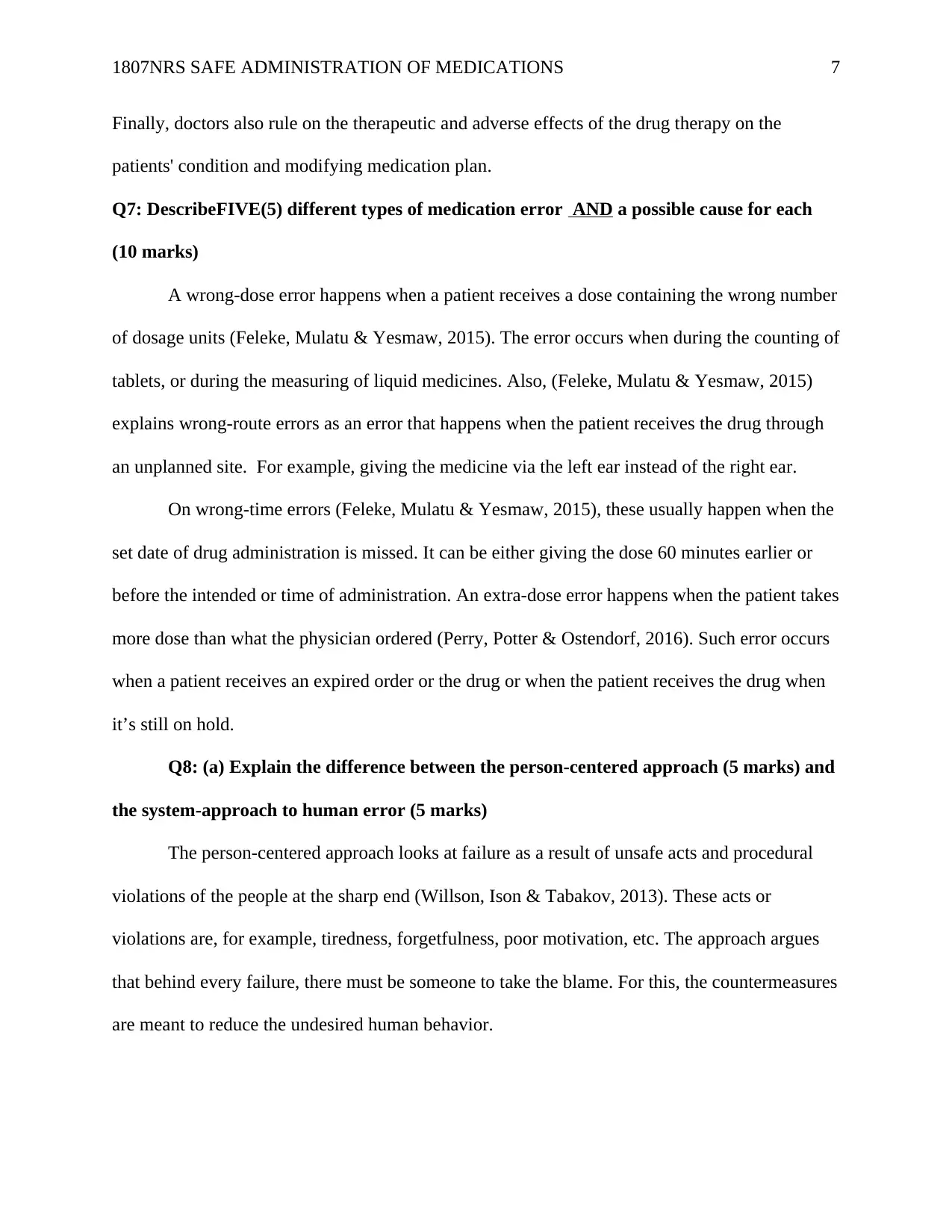
1807NRS SAFE ADMINISTRATION OF MEDICATIONS 7
Finally, doctors also rule on the therapeutic and adverse effects of the drug therapy on the
patients' condition and modifying medication plan.
Q7: DescribeFIVE(5) different types of medication error AND a possible cause for each
(10 marks)
A wrong-dose error happens when a patient receives a dose containing the wrong number
of dosage units (Feleke, Mulatu & Yesmaw, 2015). The error occurs when during the counting of
tablets, or during the measuring of liquid medicines. Also, (Feleke, Mulatu & Yesmaw, 2015)
explains wrong-route errors as an error that happens when the patient receives the drug through
an unplanned site. For example, giving the medicine via the left ear instead of the right ear.
On wrong-time errors (Feleke, Mulatu & Yesmaw, 2015), these usually happen when the
set date of drug administration is missed. It can be either giving the dose 60 minutes earlier or
before the intended or time of administration. An extra-dose error happens when the patient takes
more dose than what the physician ordered (Perry, Potter & Ostendorf, 2016). Such error occurs
when a patient receives an expired order or the drug or when the patient receives the drug when
it’s still on hold.
Q8: (a) Explain the difference between the person-centered approach (5 marks) and
the system-approach to human error (5 marks)
The person-centered approach looks at failure as a result of unsafe acts and procedural
violations of the people at the sharp end (Willson, Ison & Tabakov, 2013). These acts or
violations are, for example, tiredness, forgetfulness, poor motivation, etc. The approach argues
that behind every failure, there must be someone to take the blame. For this, the countermeasures
are meant to reduce the undesired human behavior.
Finally, doctors also rule on the therapeutic and adverse effects of the drug therapy on the
patients' condition and modifying medication plan.
Q7: DescribeFIVE(5) different types of medication error AND a possible cause for each
(10 marks)
A wrong-dose error happens when a patient receives a dose containing the wrong number
of dosage units (Feleke, Mulatu & Yesmaw, 2015). The error occurs when during the counting of
tablets, or during the measuring of liquid medicines. Also, (Feleke, Mulatu & Yesmaw, 2015)
explains wrong-route errors as an error that happens when the patient receives the drug through
an unplanned site. For example, giving the medicine via the left ear instead of the right ear.
On wrong-time errors (Feleke, Mulatu & Yesmaw, 2015), these usually happen when the
set date of drug administration is missed. It can be either giving the dose 60 minutes earlier or
before the intended or time of administration. An extra-dose error happens when the patient takes
more dose than what the physician ordered (Perry, Potter & Ostendorf, 2016). Such error occurs
when a patient receives an expired order or the drug or when the patient receives the drug when
it’s still on hold.
Q8: (a) Explain the difference between the person-centered approach (5 marks) and
the system-approach to human error (5 marks)
The person-centered approach looks at failure as a result of unsafe acts and procedural
violations of the people at the sharp end (Willson, Ison & Tabakov, 2013). These acts or
violations are, for example, tiredness, forgetfulness, poor motivation, etc. The approach argues
that behind every failure, there must be someone to take the blame. For this, the countermeasures
are meant to reduce the undesired human behavior.
Paraphrase This Document
Need a fresh take? Get an instant paraphrase of this document with our AI Paraphraser
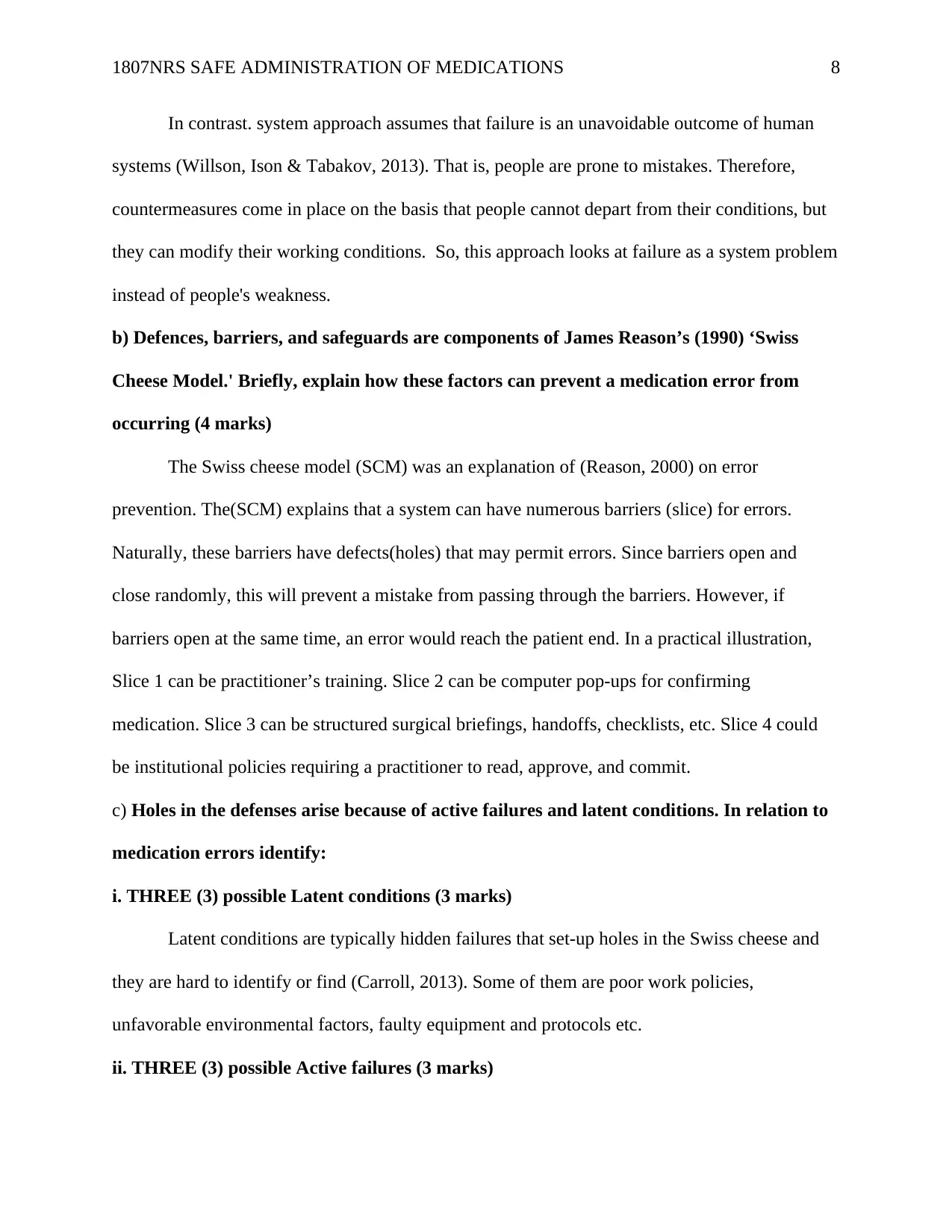
1807NRS SAFE ADMINISTRATION OF MEDICATIONS 8
In contrast. system approach assumes that failure is an unavoidable outcome of human
systems (Willson, Ison & Tabakov, 2013). That is, people are prone to mistakes. Therefore,
countermeasures come in place on the basis that people cannot depart from their conditions, but
they can modify their working conditions. So, this approach looks at failure as a system problem
instead of people's weakness.
b) Defences, barriers, and safeguards are components of James Reason’s (1990) ‘Swiss
Cheese Model.' Briefly, explain how these factors can prevent a medication error from
occurring (4 marks)
The Swiss cheese model (SCM) was an explanation of (Reason, 2000) on error
prevention. The(SCM) explains that a system can have numerous barriers (slice) for errors.
Naturally, these barriers have defects(holes) that may permit errors. Since barriers open and
close randomly, this will prevent a mistake from passing through the barriers. However, if
barriers open at the same time, an error would reach the patient end. In a practical illustration,
Slice 1 can be practitioner’s training. Slice 2 can be computer pop-ups for confirming
medication. Slice 3 can be structured surgical briefings, handoffs, checklists, etc. Slice 4 could
be institutional policies requiring a practitioner to read, approve, and commit.
c) Holes in the defenses arise because of active failures and latent conditions. In relation to
medication errors identify:
i. THREE (3) possible Latent conditions (3 marks)
Latent conditions are typically hidden failures that set-up holes in the Swiss cheese and
they are hard to identify or find (Carroll, 2013). Some of them are poor work policies,
unfavorable environmental factors, faulty equipment and protocols etc.
ii. THREE (3) possible Active failures (3 marks)
In contrast. system approach assumes that failure is an unavoidable outcome of human
systems (Willson, Ison & Tabakov, 2013). That is, people are prone to mistakes. Therefore,
countermeasures come in place on the basis that people cannot depart from their conditions, but
they can modify their working conditions. So, this approach looks at failure as a system problem
instead of people's weakness.
b) Defences, barriers, and safeguards are components of James Reason’s (1990) ‘Swiss
Cheese Model.' Briefly, explain how these factors can prevent a medication error from
occurring (4 marks)
The Swiss cheese model (SCM) was an explanation of (Reason, 2000) on error
prevention. The(SCM) explains that a system can have numerous barriers (slice) for errors.
Naturally, these barriers have defects(holes) that may permit errors. Since barriers open and
close randomly, this will prevent a mistake from passing through the barriers. However, if
barriers open at the same time, an error would reach the patient end. In a practical illustration,
Slice 1 can be practitioner’s training. Slice 2 can be computer pop-ups for confirming
medication. Slice 3 can be structured surgical briefings, handoffs, checklists, etc. Slice 4 could
be institutional policies requiring a practitioner to read, approve, and commit.
c) Holes in the defenses arise because of active failures and latent conditions. In relation to
medication errors identify:
i. THREE (3) possible Latent conditions (3 marks)
Latent conditions are typically hidden failures that set-up holes in the Swiss cheese and
they are hard to identify or find (Carroll, 2013). Some of them are poor work policies,
unfavorable environmental factors, faulty equipment and protocols etc.
ii. THREE (3) possible Active failures (3 marks)
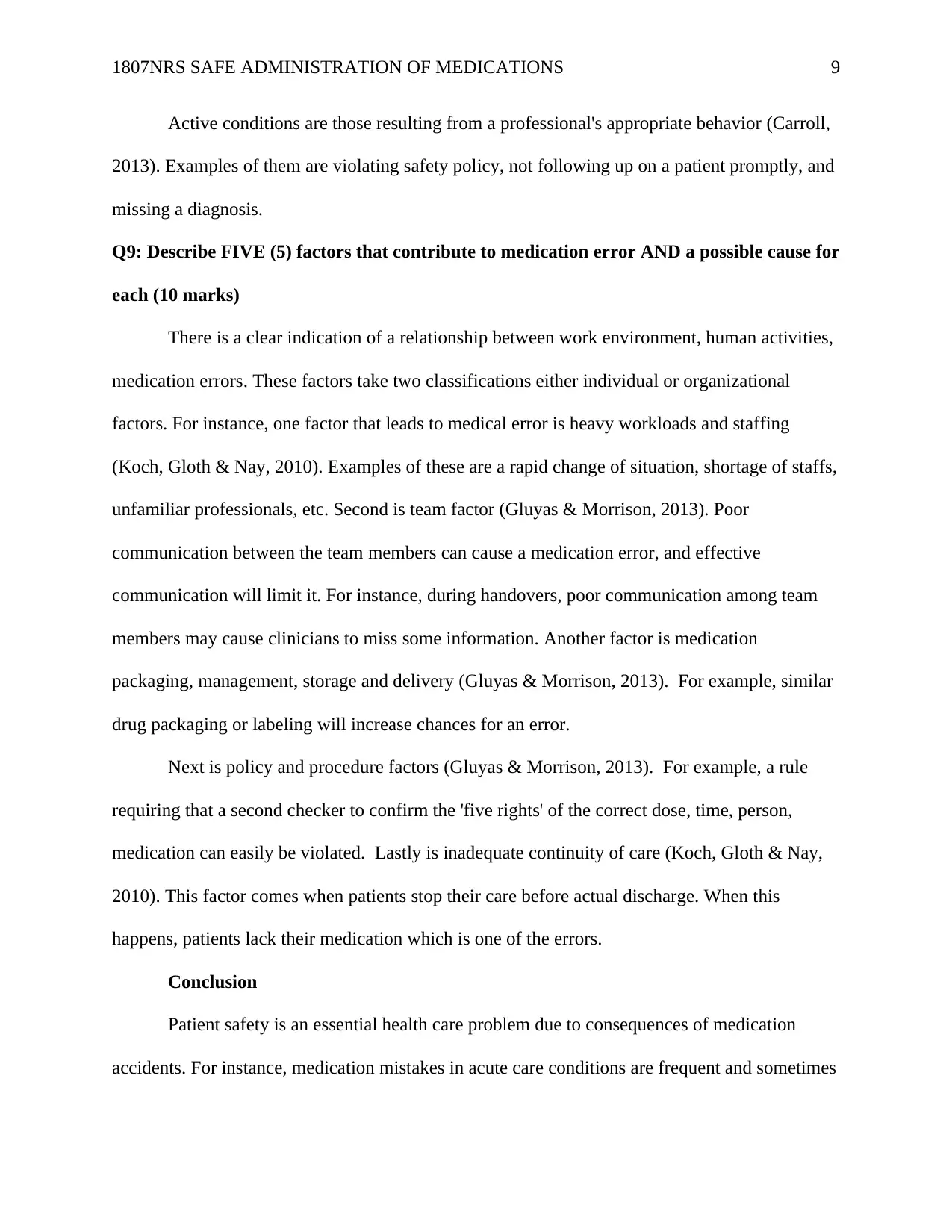
1807NRS SAFE ADMINISTRATION OF MEDICATIONS 9
Active conditions are those resulting from a professional's appropriate behavior (Carroll,
2013). Examples of them are violating safety policy, not following up on a patient promptly, and
missing a diagnosis.
Q9: Describe FIVE (5) factors that contribute to medication error AND a possible cause for
each (10 marks)
There is a clear indication of a relationship between work environment, human activities,
medication errors. These factors take two classifications either individual or organizational
factors. For instance, one factor that leads to medical error is heavy workloads and staffing
(Koch, Gloth & Nay, 2010). Examples of these are a rapid change of situation, shortage of staffs,
unfamiliar professionals, etc. Second is team factor (Gluyas & Morrison, 2013). Poor
communication between the team members can cause a medication error, and effective
communication will limit it. For instance, during handovers, poor communication among team
members may cause clinicians to miss some information. Another factor is medication
packaging, management, storage and delivery (Gluyas & Morrison, 2013). For example, similar
drug packaging or labeling will increase chances for an error.
Next is policy and procedure factors (Gluyas & Morrison, 2013). For example, a rule
requiring that a second checker to confirm the 'five rights' of the correct dose, time, person,
medication can easily be violated. Lastly is inadequate continuity of care (Koch, Gloth & Nay,
2010). This factor comes when patients stop their care before actual discharge. When this
happens, patients lack their medication which is one of the errors.
Conclusion
Patient safety is an essential health care problem due to consequences of medication
accidents. For instance, medication mistakes in acute care conditions are frequent and sometimes
Active conditions are those resulting from a professional's appropriate behavior (Carroll,
2013). Examples of them are violating safety policy, not following up on a patient promptly, and
missing a diagnosis.
Q9: Describe FIVE (5) factors that contribute to medication error AND a possible cause for
each (10 marks)
There is a clear indication of a relationship between work environment, human activities,
medication errors. These factors take two classifications either individual or organizational
factors. For instance, one factor that leads to medical error is heavy workloads and staffing
(Koch, Gloth & Nay, 2010). Examples of these are a rapid change of situation, shortage of staffs,
unfamiliar professionals, etc. Second is team factor (Gluyas & Morrison, 2013). Poor
communication between the team members can cause a medication error, and effective
communication will limit it. For instance, during handovers, poor communication among team
members may cause clinicians to miss some information. Another factor is medication
packaging, management, storage and delivery (Gluyas & Morrison, 2013). For example, similar
drug packaging or labeling will increase chances for an error.
Next is policy and procedure factors (Gluyas & Morrison, 2013). For example, a rule
requiring that a second checker to confirm the 'five rights' of the correct dose, time, person,
medication can easily be violated. Lastly is inadequate continuity of care (Koch, Gloth & Nay,
2010). This factor comes when patients stop their care before actual discharge. When this
happens, patients lack their medication which is one of the errors.
Conclusion
Patient safety is an essential health care problem due to consequences of medication
accidents. For instance, medication mistakes in acute care conditions are frequent and sometimes
⊘ This is a preview!⊘
Do you want full access?
Subscribe today to unlock all pages.

Trusted by 1+ million students worldwide
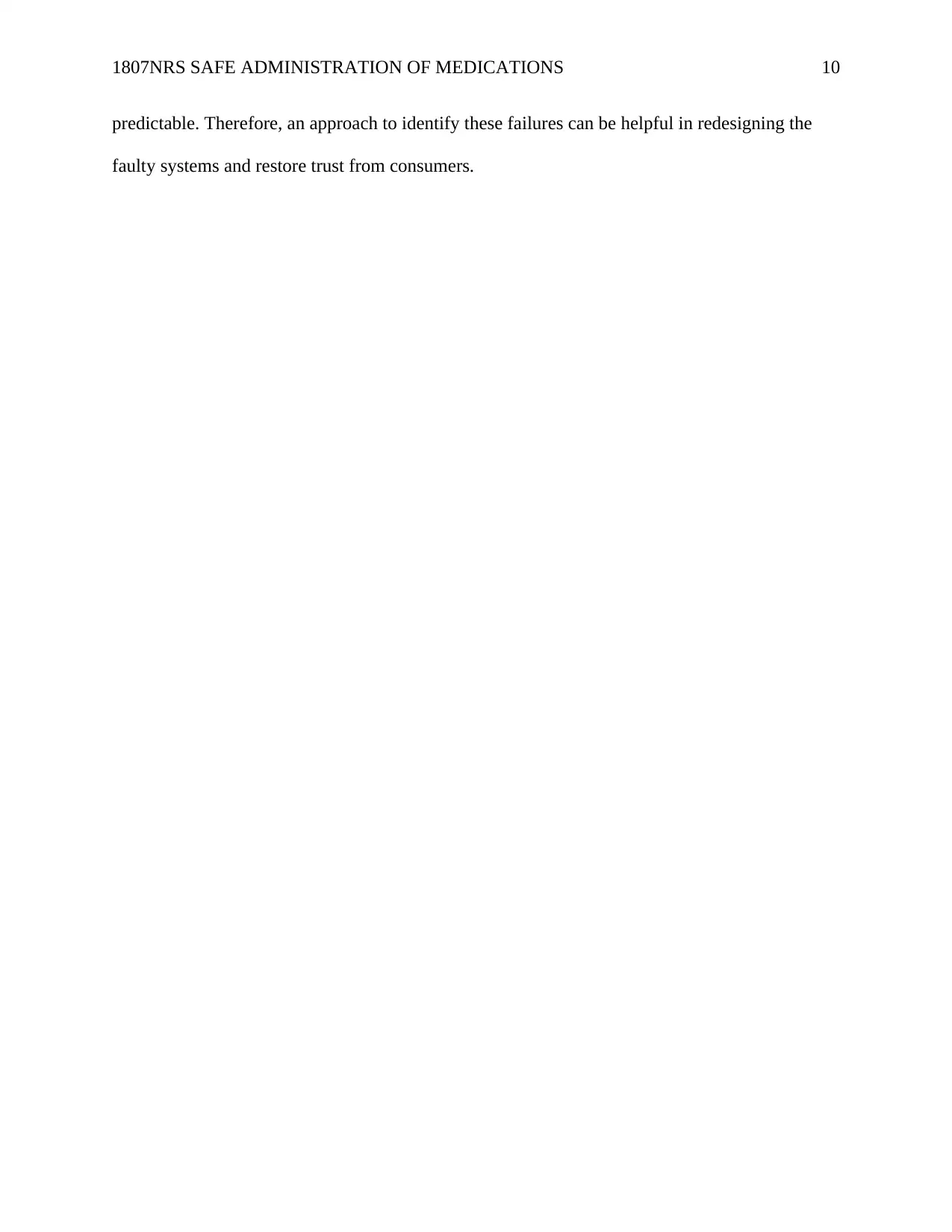
1807NRS SAFE ADMINISTRATION OF MEDICATIONS 10
predictable. Therefore, an approach to identify these failures can be helpful in redesigning the
faulty systems and restore trust from consumers.
predictable. Therefore, an approach to identify these failures can be helpful in redesigning the
faulty systems and restore trust from consumers.
Paraphrase This Document
Need a fresh take? Get an instant paraphrase of this document with our AI Paraphraser
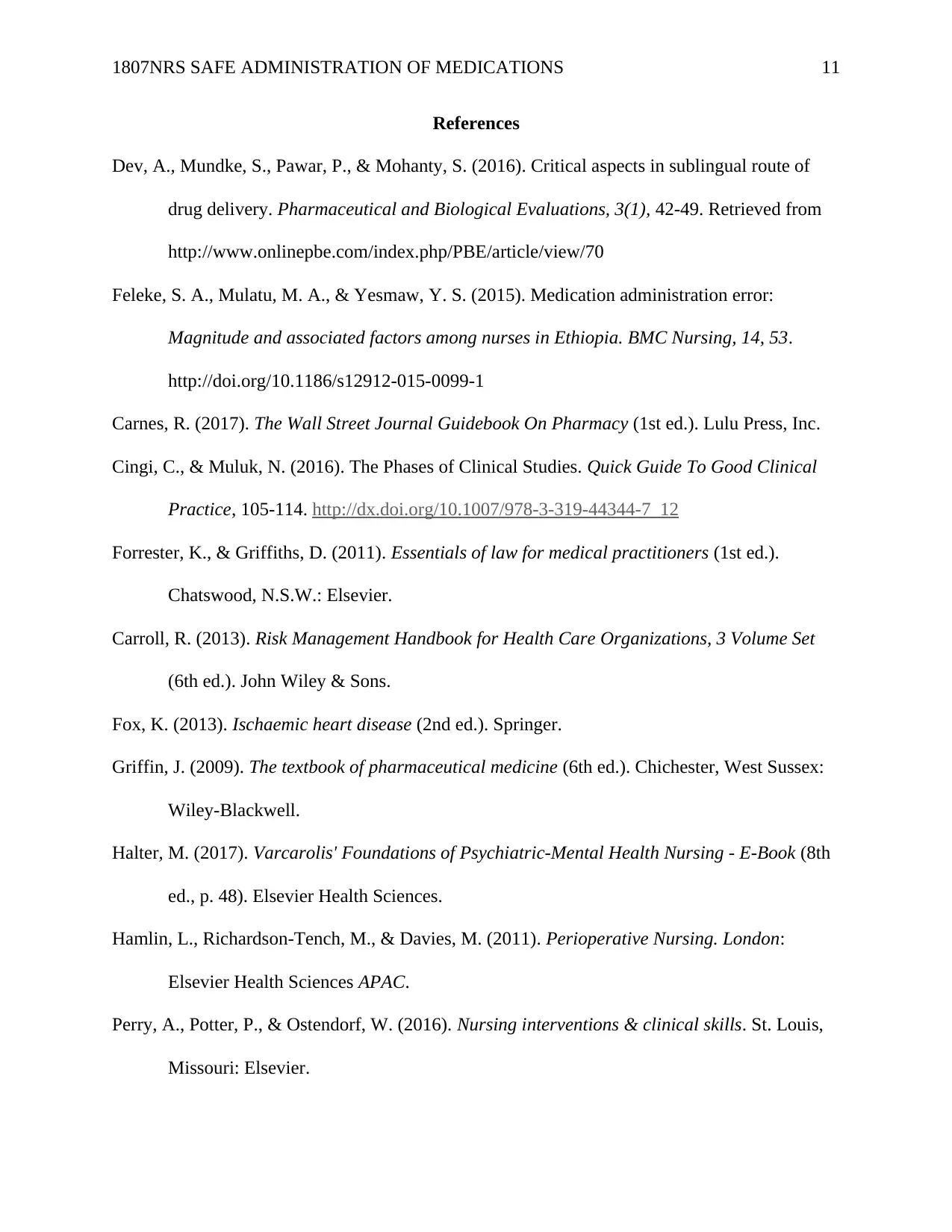
1807NRS SAFE ADMINISTRATION OF MEDICATIONS 11
References
Dev, A., Mundke, S., Pawar, P., & Mohanty, S. (2016). Critical aspects in sublingual route of
drug delivery. Pharmaceutical and Biological Evaluations, 3(1), 42-49. Retrieved from
http://www.onlinepbe.com/index.php/PBE/article/view/70
Feleke, S. A., Mulatu, M. A., & Yesmaw, Y. S. (2015). Medication administration error:
Magnitude and associated factors among nurses in Ethiopia. BMC Nursing, 14, 53.
http://doi.org/10.1186/s12912-015-0099-1
Carnes, R. (2017). The Wall Street Journal Guidebook On Pharmacy (1st ed.). Lulu Press, Inc.
Cingi, C., & Muluk, N. (2016). The Phases of Clinical Studies. Quick Guide To Good Clinical
Practice, 105-114. http://dx.doi.org/10.1007/978-3-319-44344-7_12
Forrester, K., & Griffiths, D. (2011). Essentials of law for medical practitioners (1st ed.).
Chatswood, N.S.W.: Elsevier.
Carroll, R. (2013). Risk Management Handbook for Health Care Organizations, 3 Volume Set
(6th ed.). John Wiley & Sons.
Fox, K. (2013). Ischaemic heart disease (2nd ed.). Springer.
Griffin, J. (2009). The textbook of pharmaceutical medicine (6th ed.). Chichester, West Sussex:
Wiley-Blackwell.
Halter, M. (2017). Varcarolis' Foundations of Psychiatric-Mental Health Nursing - E-Book (8th
ed., p. 48). Elsevier Health Sciences.
Hamlin, L., Richardson-Tench, M., & Davies, M. (2011). Perioperative Nursing. London:
Elsevier Health Sciences APAC.
Perry, A., Potter, P., & Ostendorf, W. (2016). Nursing interventions & clinical skills. St. Louis,
Missouri: Elsevier.
References
Dev, A., Mundke, S., Pawar, P., & Mohanty, S. (2016). Critical aspects in sublingual route of
drug delivery. Pharmaceutical and Biological Evaluations, 3(1), 42-49. Retrieved from
http://www.onlinepbe.com/index.php/PBE/article/view/70
Feleke, S. A., Mulatu, M. A., & Yesmaw, Y. S. (2015). Medication administration error:
Magnitude and associated factors among nurses in Ethiopia. BMC Nursing, 14, 53.
http://doi.org/10.1186/s12912-015-0099-1
Carnes, R. (2017). The Wall Street Journal Guidebook On Pharmacy (1st ed.). Lulu Press, Inc.
Cingi, C., & Muluk, N. (2016). The Phases of Clinical Studies. Quick Guide To Good Clinical
Practice, 105-114. http://dx.doi.org/10.1007/978-3-319-44344-7_12
Forrester, K., & Griffiths, D. (2011). Essentials of law for medical practitioners (1st ed.).
Chatswood, N.S.W.: Elsevier.
Carroll, R. (2013). Risk Management Handbook for Health Care Organizations, 3 Volume Set
(6th ed.). John Wiley & Sons.
Fox, K. (2013). Ischaemic heart disease (2nd ed.). Springer.
Griffin, J. (2009). The textbook of pharmaceutical medicine (6th ed.). Chichester, West Sussex:
Wiley-Blackwell.
Halter, M. (2017). Varcarolis' Foundations of Psychiatric-Mental Health Nursing - E-Book (8th
ed., p. 48). Elsevier Health Sciences.
Hamlin, L., Richardson-Tench, M., & Davies, M. (2011). Perioperative Nursing. London:
Elsevier Health Sciences APAC.
Perry, A., Potter, P., & Ostendorf, W. (2016). Nursing interventions & clinical skills. St. Louis,
Missouri: Elsevier.
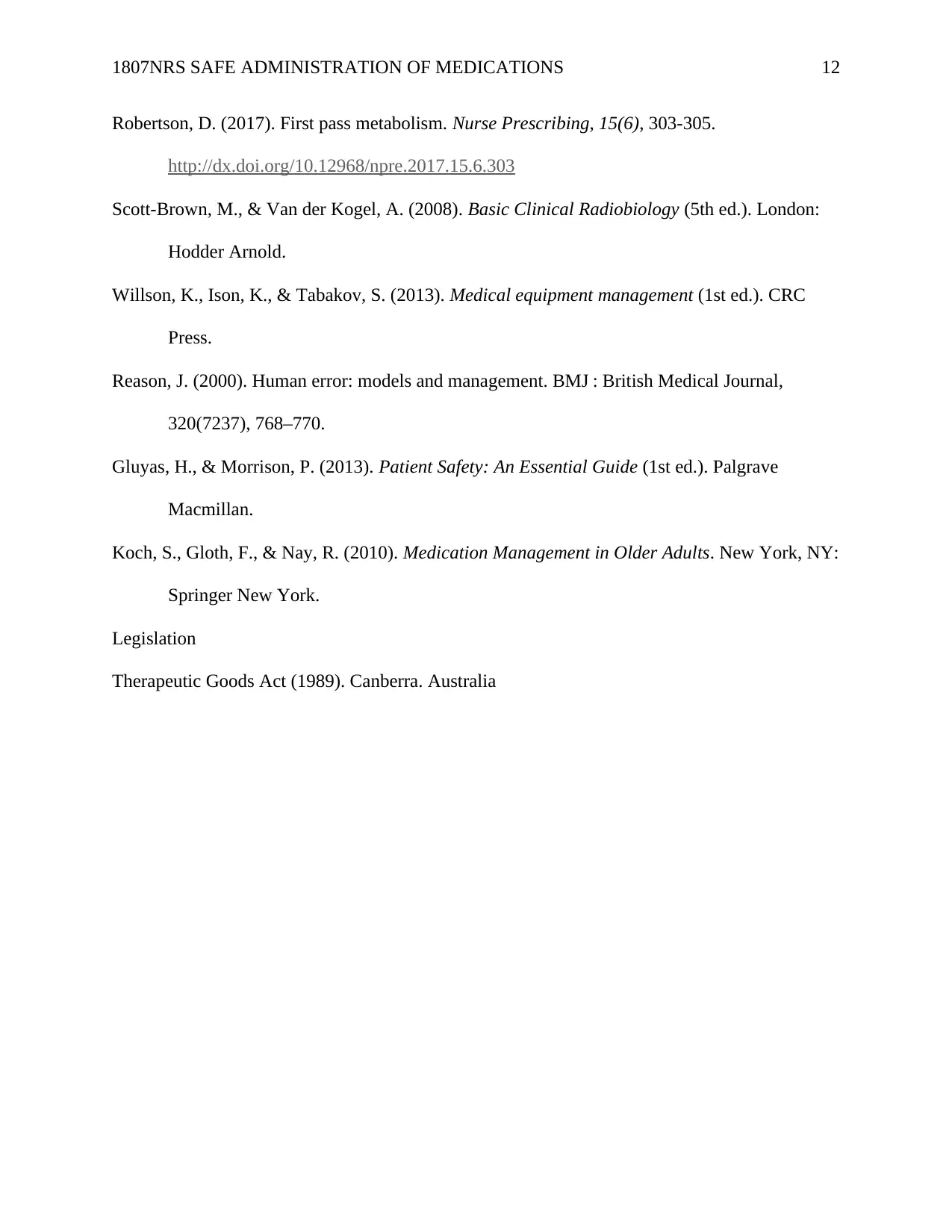
1807NRS SAFE ADMINISTRATION OF MEDICATIONS 12
Robertson, D. (2017). First pass metabolism. Nurse Prescribing, 15(6), 303-305.
http://dx.doi.org/10.12968/npre.2017.15.6.303
Scott-Brown, M., & Van der Kogel, A. (2008). Basic Clinical Radiobiology (5th ed.). London:
Hodder Arnold.
Willson, K., Ison, K., & Tabakov, S. (2013). Medical equipment management (1st ed.). CRC
Press.
Reason, J. (2000). Human error: models and management. BMJ : British Medical Journal,
320(7237), 768–770.
Gluyas, H., & Morrison, P. (2013). Patient Safety: An Essential Guide (1st ed.). Palgrave
Macmillan.
Koch, S., Gloth, F., & Nay, R. (2010). Medication Management in Older Adults. New York, NY:
Springer New York.
Legislation
Therapeutic Goods Act (1989). Canberra. Australia
Robertson, D. (2017). First pass metabolism. Nurse Prescribing, 15(6), 303-305.
http://dx.doi.org/10.12968/npre.2017.15.6.303
Scott-Brown, M., & Van der Kogel, A. (2008). Basic Clinical Radiobiology (5th ed.). London:
Hodder Arnold.
Willson, K., Ison, K., & Tabakov, S. (2013). Medical equipment management (1st ed.). CRC
Press.
Reason, J. (2000). Human error: models and management. BMJ : British Medical Journal,
320(7237), 768–770.
Gluyas, H., & Morrison, P. (2013). Patient Safety: An Essential Guide (1st ed.). Palgrave
Macmillan.
Koch, S., Gloth, F., & Nay, R. (2010). Medication Management in Older Adults. New York, NY:
Springer New York.
Legislation
Therapeutic Goods Act (1989). Canberra. Australia
⊘ This is a preview!⊘
Do you want full access?
Subscribe today to unlock all pages.

Trusted by 1+ million students worldwide
1 out of 12
Related Documents
Your All-in-One AI-Powered Toolkit for Academic Success.
+13062052269
info@desklib.com
Available 24*7 on WhatsApp / Email
![[object Object]](/_next/static/media/star-bottom.7253800d.svg)
Unlock your academic potential
Copyright © 2020–2025 A2Z Services. All Rights Reserved. Developed and managed by ZUCOL.





